Analyzing Conceptual Design Phase of the Maglev Bullet Train Project
VerifiedAdded on 2022/12/30
|14
|3150
|73
Report
AI Summary
This report provides a comprehensive analysis of the conceptual design phase of the Maglev Bullet Train project, focusing on the system engineering aspects of the project. The report begins with an introduction that highlights the importance of the conceptual design phase, which is the initial stage of the project. It then delves into the stakeholder needs, differentiating between internal and external stakeholders like the Central Japan Railway Company (JRC), U.S-Japan High-Speed Rail (USJHSR), and U.S.‐Japan MAGLEV (USJMAGLEV), and their respective requirements. The report continues by exploring the conceptual design process, including the working principles of Maglev trains, the functionality of the guideways, and the technologies of propulsion, levitation (Electromagnetic Suspension (EMS) and Electrodynamic Suspension (EDS)), and guidance. The report also discusses the system requirements of the Maglev technology. The report concludes with a summary of the main findings and a discussion of the benefits of the conceptual design phase in the development of the Maglev Bullet Train project.
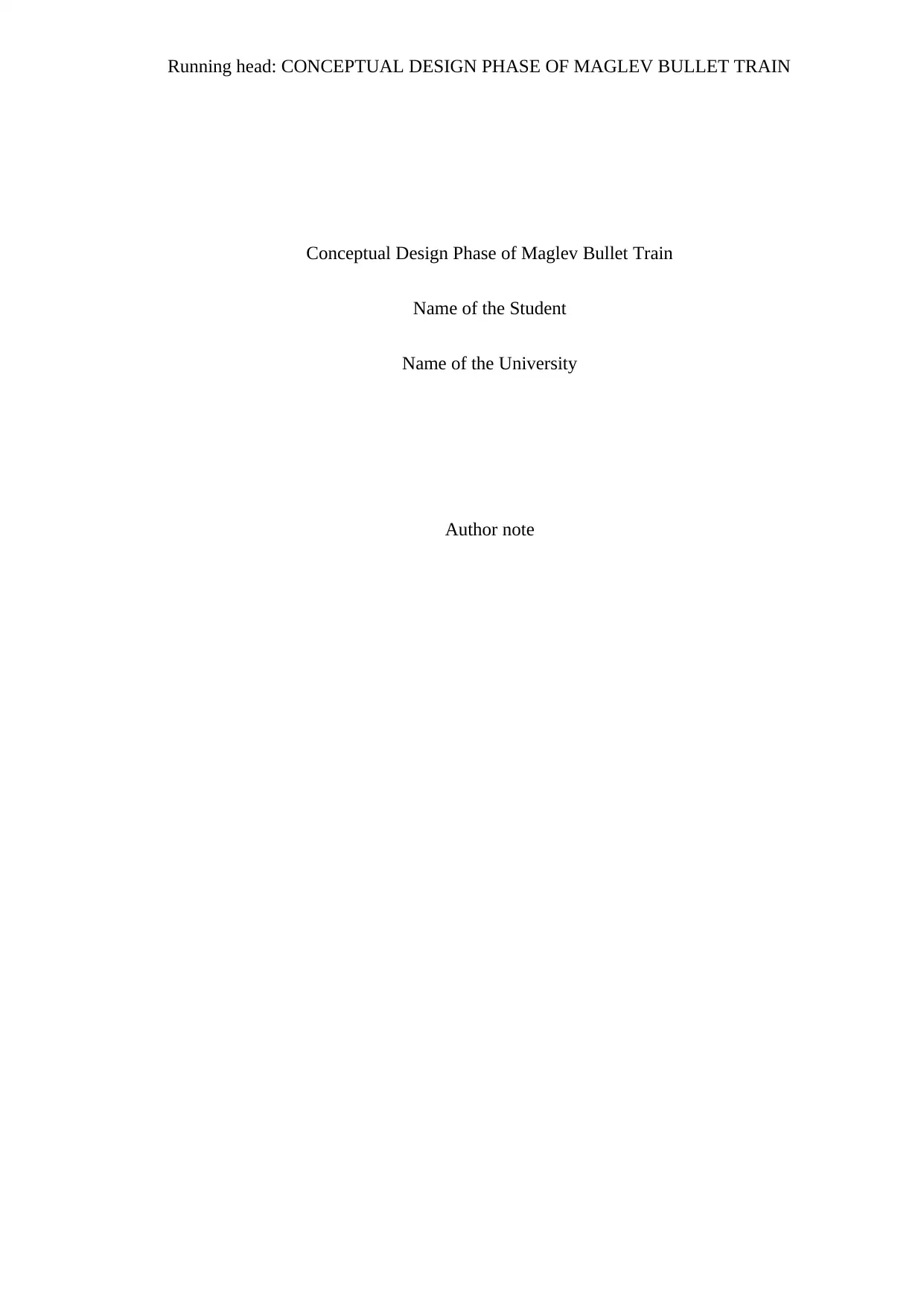
Running head: CONCEPTUAL DESIGN PHASE OF MAGLEV BULLET TRAIN
Conceptual Design Phase of Maglev Bullet Train
Name of the Student
Name of the University
Author note
Conceptual Design Phase of Maglev Bullet Train
Name of the Student
Name of the University
Author note
Paraphrase This Document
Need a fresh take? Get an instant paraphrase of this document with our AI Paraphraser

1CONCEPTUAL DESIGN PHASE OF MAGLEV BULLET TRAIN
Table of Contents
Introduction 2
Stakeholder needs 2
Conceptual design process 4
System requirements 9
Conclusion 10
References 11
Table of Contents
Introduction 2
Stakeholder needs 2
Conceptual design process 4
System requirements 9
Conclusion 10
References 11
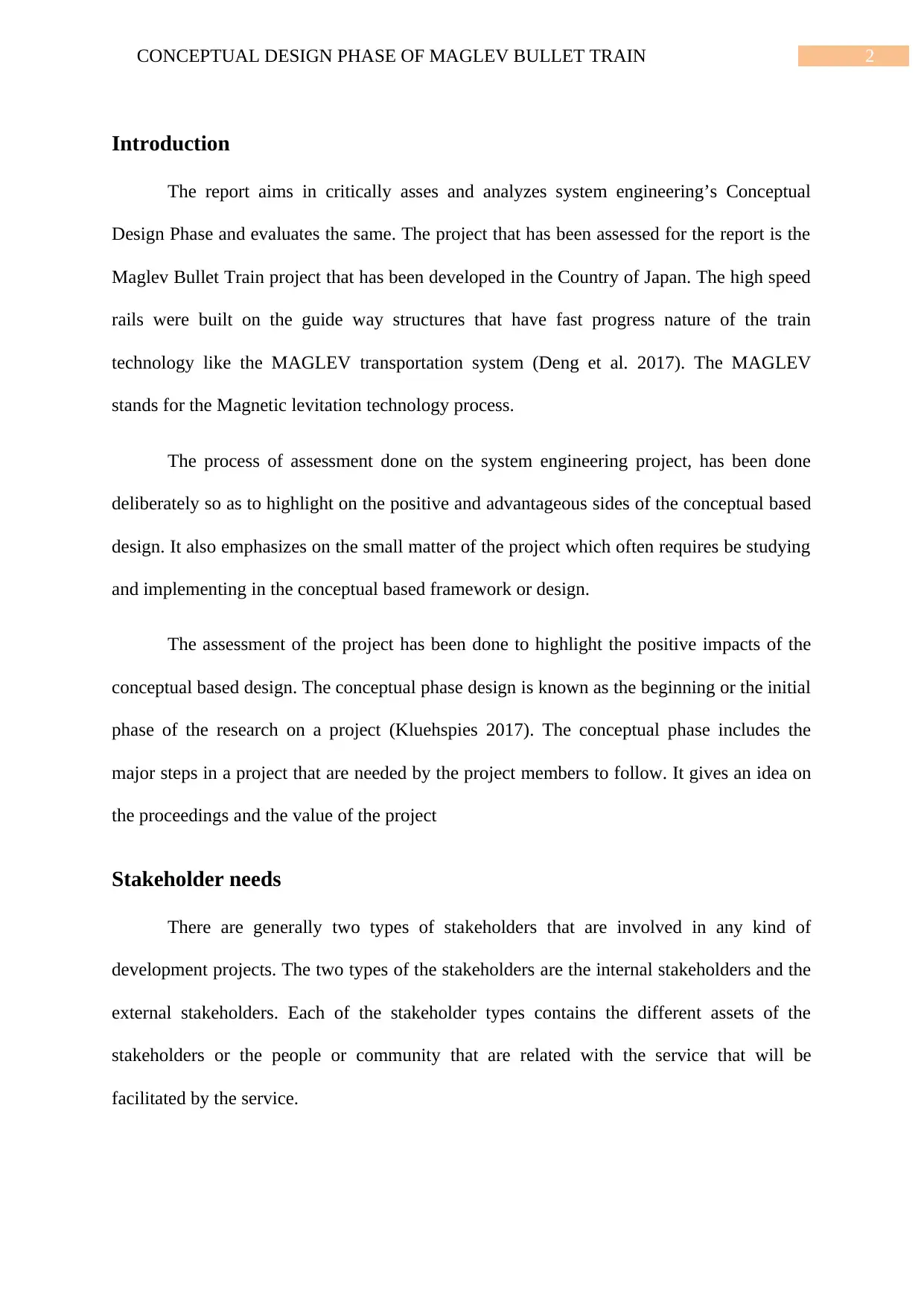
2CONCEPTUAL DESIGN PHASE OF MAGLEV BULLET TRAIN
Introduction
The report aims in critically asses and analyzes system engineering’s Conceptual
Design Phase and evaluates the same. The project that has been assessed for the report is the
Maglev Bullet Train project that has been developed in the Country of Japan. The high speed
rails were built on the guide way structures that have fast progress nature of the train
technology like the MAGLEV transportation system (Deng et al. 2017). The MAGLEV
stands for the Magnetic levitation technology process.
The process of assessment done on the system engineering project, has been done
deliberately so as to highlight on the positive and advantageous sides of the conceptual based
design. It also emphasizes on the small matter of the project which often requires be studying
and implementing in the conceptual based framework or design.
The assessment of the project has been done to highlight the positive impacts of the
conceptual based design. The conceptual phase design is known as the beginning or the initial
phase of the research on a project (Kluehspies 2017). The conceptual phase includes the
major steps in a project that are needed by the project members to follow. It gives an idea on
the proceedings and the value of the project
Stakeholder needs
There are generally two types of stakeholders that are involved in any kind of
development projects. The two types of the stakeholders are the internal stakeholders and the
external stakeholders. Each of the stakeholder types contains the different assets of the
stakeholders or the people or community that are related with the service that will be
facilitated by the service.
Introduction
The report aims in critically asses and analyzes system engineering’s Conceptual
Design Phase and evaluates the same. The project that has been assessed for the report is the
Maglev Bullet Train project that has been developed in the Country of Japan. The high speed
rails were built on the guide way structures that have fast progress nature of the train
technology like the MAGLEV transportation system (Deng et al. 2017). The MAGLEV
stands for the Magnetic levitation technology process.
The process of assessment done on the system engineering project, has been done
deliberately so as to highlight on the positive and advantageous sides of the conceptual based
design. It also emphasizes on the small matter of the project which often requires be studying
and implementing in the conceptual based framework or design.
The assessment of the project has been done to highlight the positive impacts of the
conceptual based design. The conceptual phase design is known as the beginning or the initial
phase of the research on a project (Kluehspies 2017). The conceptual phase includes the
major steps in a project that are needed by the project members to follow. It gives an idea on
the proceedings and the value of the project
Stakeholder needs
There are generally two types of stakeholders that are involved in any kind of
development projects. The two types of the stakeholders are the internal stakeholders and the
external stakeholders. Each of the stakeholder types contains the different assets of the
stakeholders or the people or community that are related with the service that will be
facilitated by the service.
⊘ This is a preview!⊘
Do you want full access?
Subscribe today to unlock all pages.

Trusted by 1+ million students worldwide
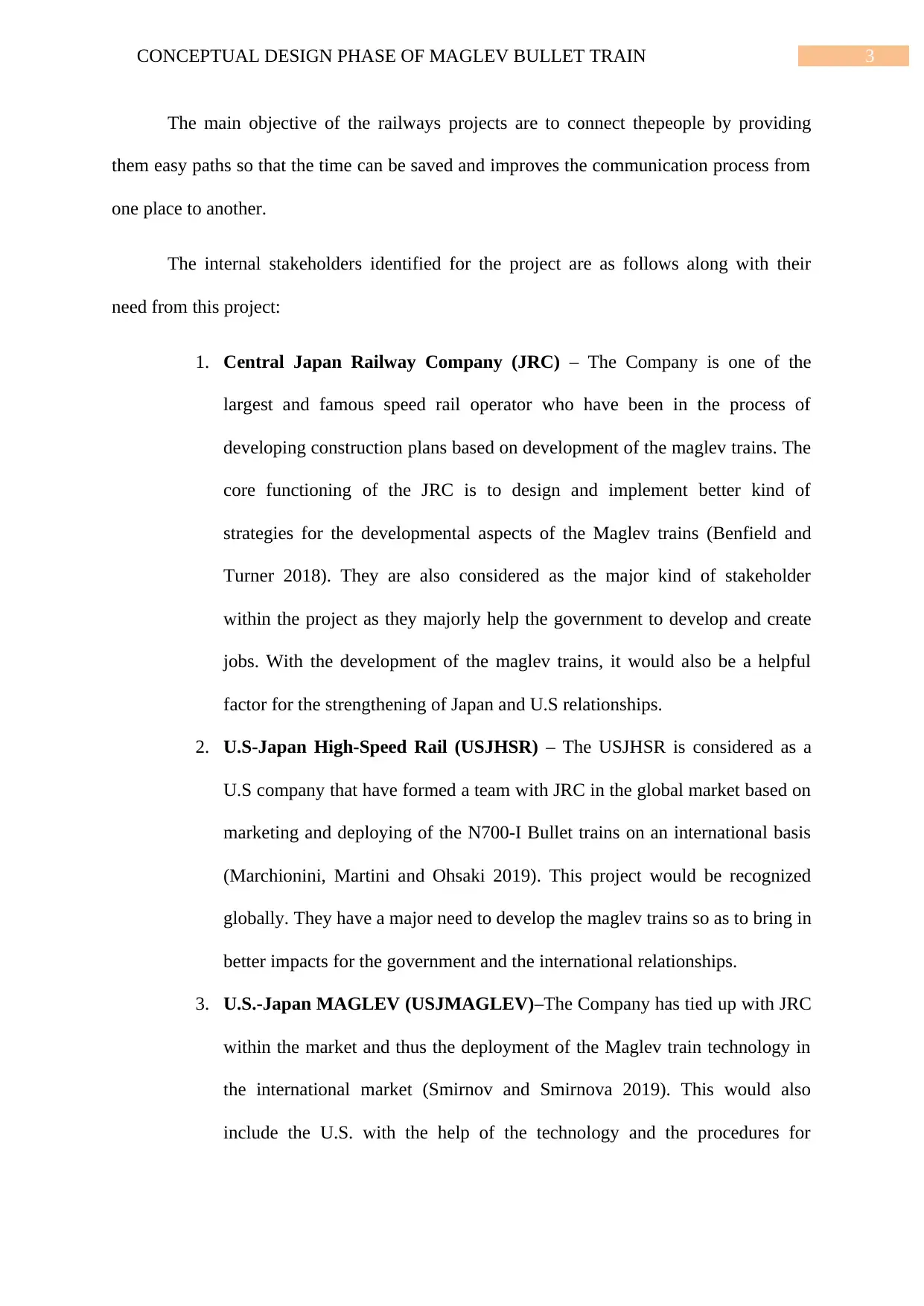
3CONCEPTUAL DESIGN PHASE OF MAGLEV BULLET TRAIN
The main objective of the railways projects are to connect thepeople by providing
them easy paths so that the time can be saved and improves the communication process from
one place to another.
The internal stakeholders identified for the project are as follows along with their
need from this project:
1. Central Japan Railway Company (JRC) – The Company is one of the
largest and famous speed rail operator who have been in the process of
developing construction plans based on development of the maglev trains. The
core functioning of the JRC is to design and implement better kind of
strategies for the developmental aspects of the Maglev trains (Benfield and
Turner 2018). They are also considered as the major kind of stakeholder
within the project as they majorly help the government to develop and create
jobs. With the development of the maglev trains, it would also be a helpful
factor for the strengthening of Japan and U.S relationships.
2. U.S-Japan High-Speed Rail (USJHSR) – The USJHSR is considered as a
U.S company that have formed a team with JRC in the global market based on
marketing and deploying of the N700-I Bullet trains on an international basis
(Marchionini, Martini and Ohsaki 2019). This project would be recognized
globally. They have a major need to develop the maglev trains so as to bring in
better impacts for the government and the international relationships.
3. U.S.‐Japan MAGLEV (USJMAGLEV)–The Company has tied up with JRC
within the market and thus the deployment of the Maglev train technology in
the international market (Smirnov and Smirnova 2019). This would also
include the U.S. with the help of the technology and the procedures for
The main objective of the railways projects are to connect thepeople by providing
them easy paths so that the time can be saved and improves the communication process from
one place to another.
The internal stakeholders identified for the project are as follows along with their
need from this project:
1. Central Japan Railway Company (JRC) – The Company is one of the
largest and famous speed rail operator who have been in the process of
developing construction plans based on development of the maglev trains. The
core functioning of the JRC is to design and implement better kind of
strategies for the developmental aspects of the Maglev trains (Benfield and
Turner 2018). They are also considered as the major kind of stakeholder
within the project as they majorly help the government to develop and create
jobs. With the development of the maglev trains, it would also be a helpful
factor for the strengthening of Japan and U.S relationships.
2. U.S-Japan High-Speed Rail (USJHSR) – The USJHSR is considered as a
U.S company that have formed a team with JRC in the global market based on
marketing and deploying of the N700-I Bullet trains on an international basis
(Marchionini, Martini and Ohsaki 2019). This project would be recognized
globally. They have a major need to develop the maglev trains so as to bring in
better impacts for the government and the international relationships.
3. U.S.‐Japan MAGLEV (USJMAGLEV)–The Company has tied up with JRC
within the market and thus the deployment of the Maglev train technology in
the international market (Smirnov and Smirnova 2019). This would also
include the U.S. with the help of the technology and the procedures for
Paraphrase This Document
Need a fresh take? Get an instant paraphrase of this document with our AI Paraphraser
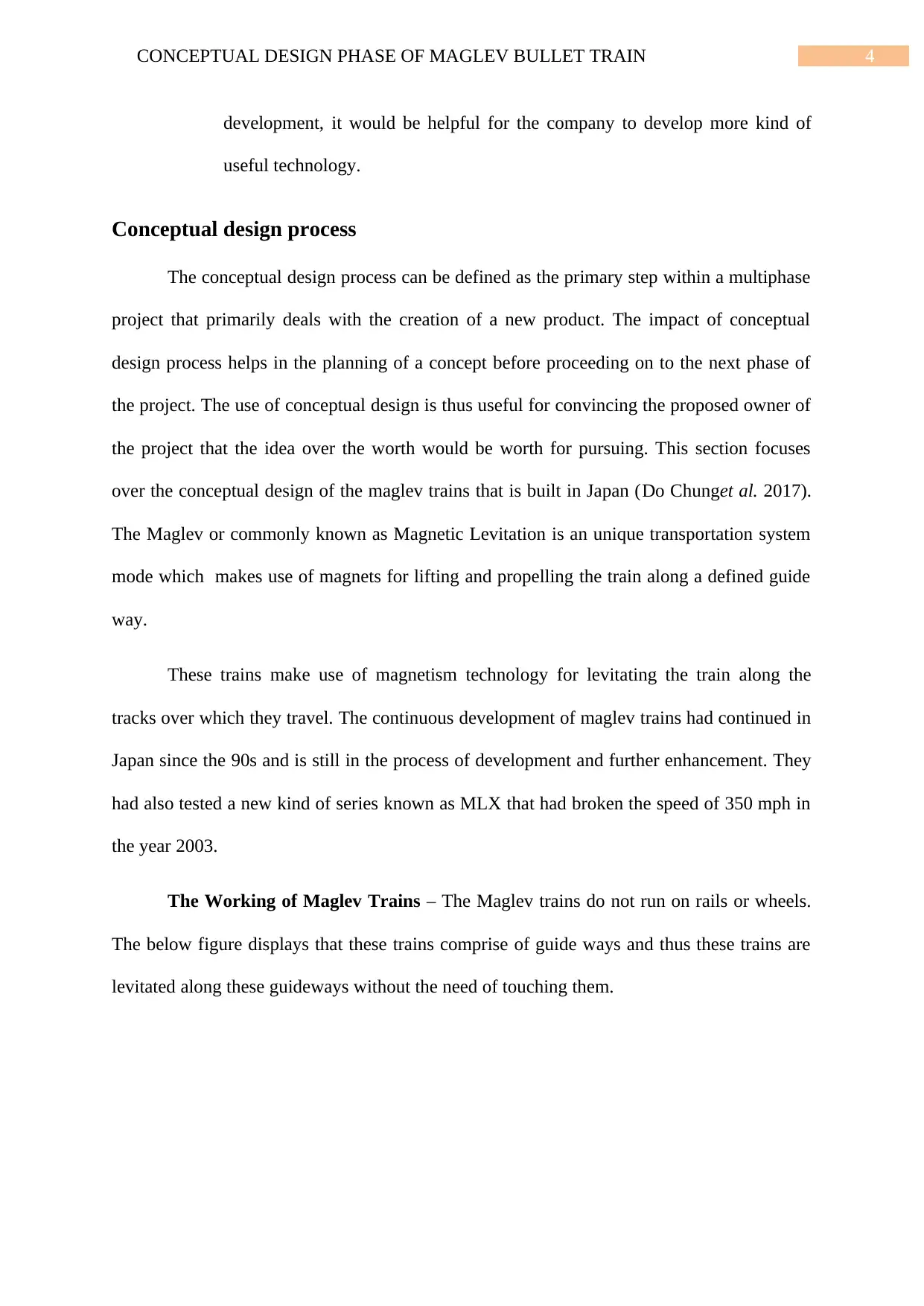
4CONCEPTUAL DESIGN PHASE OF MAGLEV BULLET TRAIN
development, it would be helpful for the company to develop more kind of
useful technology.
Conceptual design process
The conceptual design process can be defined as the primary step within a multiphase
project that primarily deals with the creation of a new product. The impact of conceptual
design process helps in the planning of a concept before proceeding on to the next phase of
the project. The use of conceptual design is thus useful for convincing the proposed owner of
the project that the idea over the worth would be worth for pursuing. This section focuses
over the conceptual design of the maglev trains that is built in Japan (Do Chunget al. 2017).
The Maglev or commonly known as Magnetic Levitation is an unique transportation system
mode which makes use of magnets for lifting and propelling the train along a defined guide
way.
These trains make use of magnetism technology for levitating the train along the
tracks over which they travel. The continuous development of maglev trains had continued in
Japan since the 90s and is still in the process of development and further enhancement. They
had also tested a new kind of series known as MLX that had broken the speed of 350 mph in
the year 2003.
The Working of Maglev Trains – The Maglev trains do not run on rails or wheels.
The below figure displays that these trains comprise of guide ways and thus these trains are
levitated along these guideways without the need of touching them.
development, it would be helpful for the company to develop more kind of
useful technology.
Conceptual design process
The conceptual design process can be defined as the primary step within a multiphase
project that primarily deals with the creation of a new product. The impact of conceptual
design process helps in the planning of a concept before proceeding on to the next phase of
the project. The use of conceptual design is thus useful for convincing the proposed owner of
the project that the idea over the worth would be worth for pursuing. This section focuses
over the conceptual design of the maglev trains that is built in Japan (Do Chunget al. 2017).
The Maglev or commonly known as Magnetic Levitation is an unique transportation system
mode which makes use of magnets for lifting and propelling the train along a defined guide
way.
These trains make use of magnetism technology for levitating the train along the
tracks over which they travel. The continuous development of maglev trains had continued in
Japan since the 90s and is still in the process of development and further enhancement. They
had also tested a new kind of series known as MLX that had broken the speed of 350 mph in
the year 2003.
The Working of Maglev Trains – The Maglev trains do not run on rails or wheels.
The below figure displays that these trains comprise of guide ways and thus these trains are
levitated along these guideways without the need of touching them.
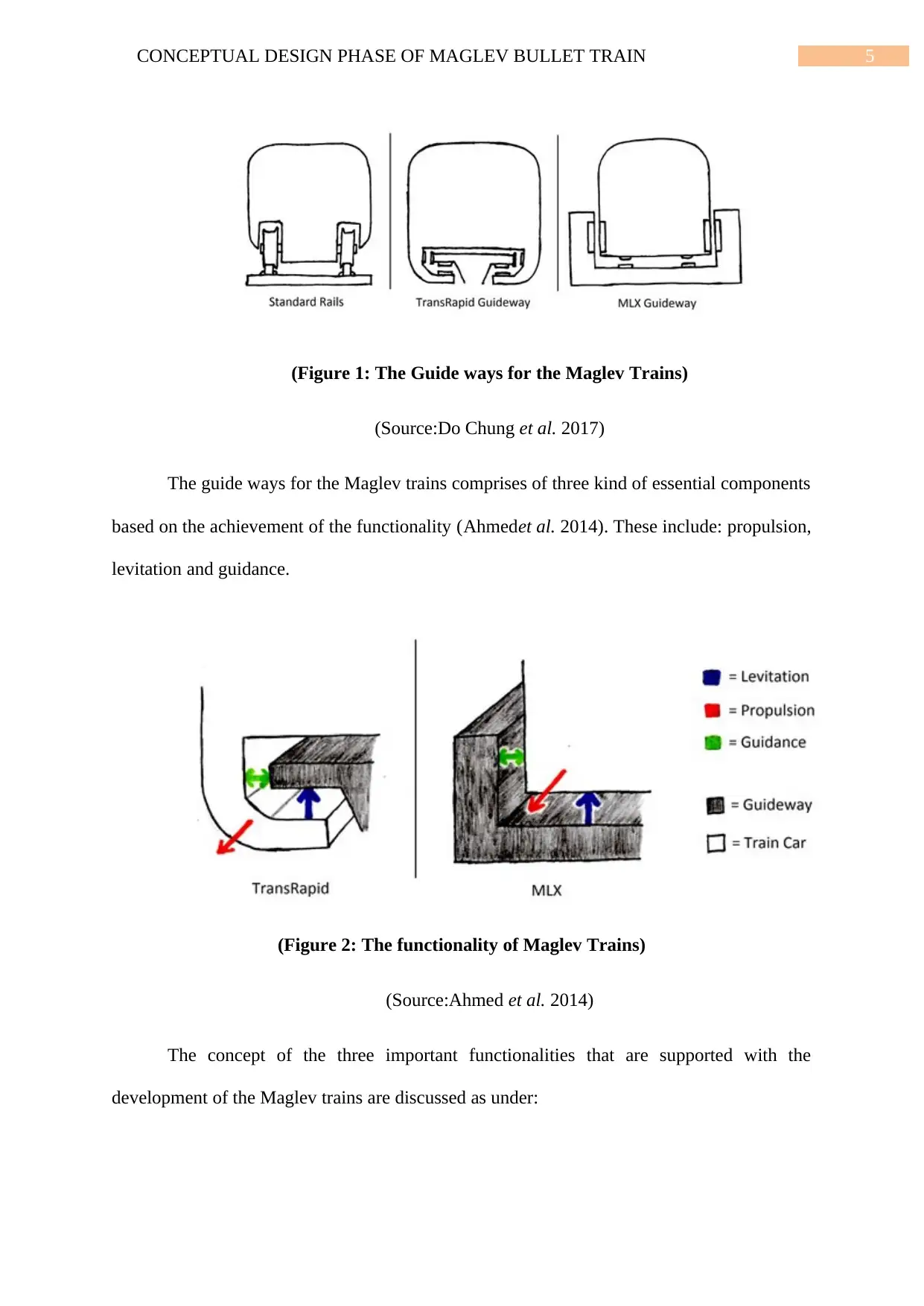
5CONCEPTUAL DESIGN PHASE OF MAGLEV BULLET TRAIN
(Figure 1: The Guide ways for the Maglev Trains)
(Source:Do Chung et al. 2017)
The guide ways for the Maglev trains comprises of three kind of essential components
based on the achievement of the functionality (Ahmedet al. 2014). These include: propulsion,
levitation and guidance.
(Figure 2: The functionality of Maglev Trains)
(Source:Ahmed et al. 2014)
The concept of the three important functionalities that are supported with the
development of the Maglev trains are discussed as under:
(Figure 1: The Guide ways for the Maglev Trains)
(Source:Do Chung et al. 2017)
The guide ways for the Maglev trains comprises of three kind of essential components
based on the achievement of the functionality (Ahmedet al. 2014). These include: propulsion,
levitation and guidance.
(Figure 2: The functionality of Maglev Trains)
(Source:Ahmed et al. 2014)
The concept of the three important functionalities that are supported with the
development of the Maglev trains are discussed as under:
⊘ This is a preview!⊘
Do you want full access?
Subscribe today to unlock all pages.

Trusted by 1+ million students worldwide
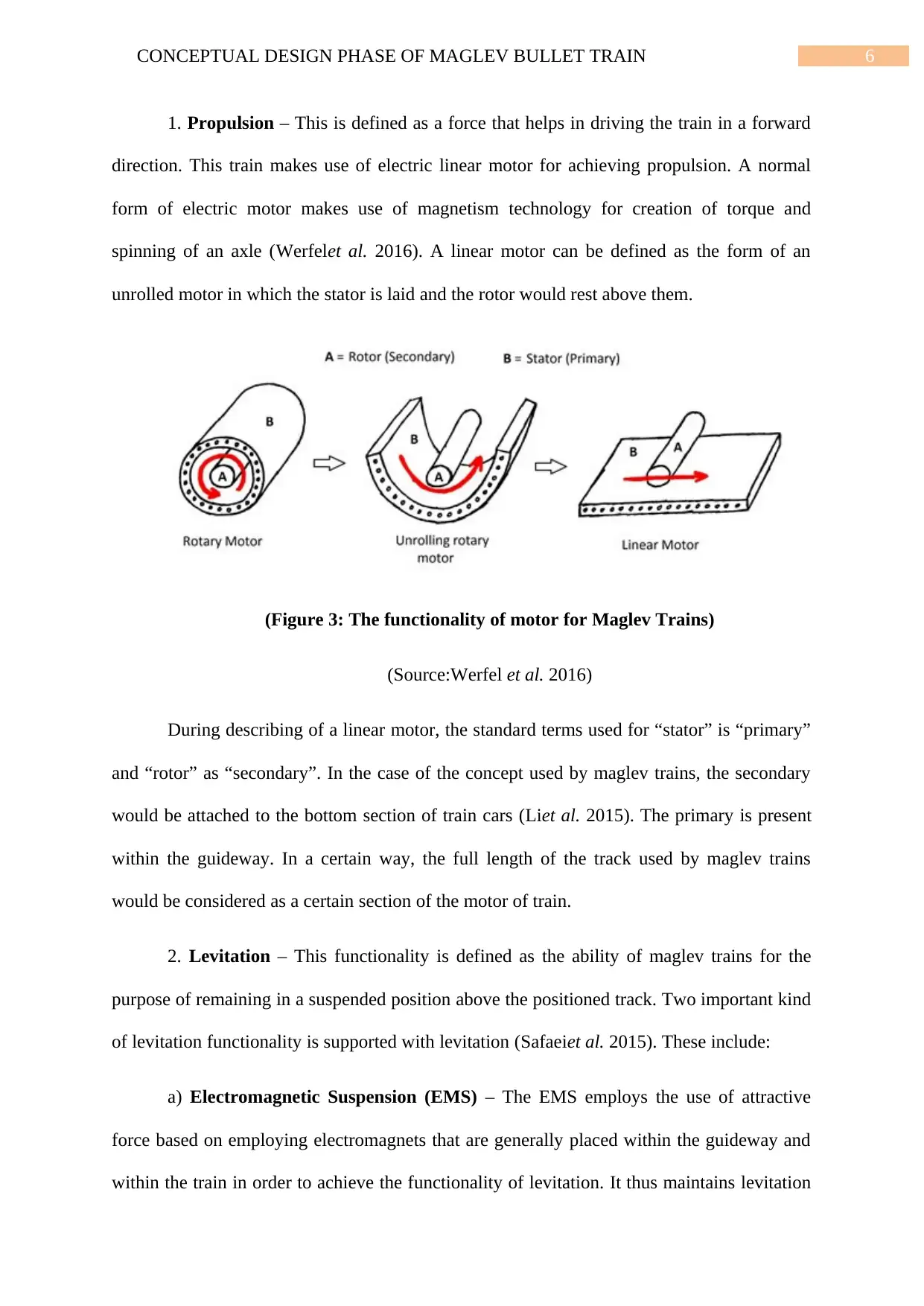
6CONCEPTUAL DESIGN PHASE OF MAGLEV BULLET TRAIN
1. Propulsion – This is defined as a force that helps in driving the train in a forward
direction. This train makes use of electric linear motor for achieving propulsion. A normal
form of electric motor makes use of magnetism technology for creation of torque and
spinning of an axle (Werfelet al. 2016). A linear motor can be defined as the form of an
unrolled motor in which the stator is laid and the rotor would rest above them.
(Figure 3: The functionality of motor for Maglev Trains)
(Source:Werfel et al. 2016)
During describing of a linear motor, the standard terms used for “stator” is “primary”
and “rotor” as “secondary”. In the case of the concept used by maglev trains, the secondary
would be attached to the bottom section of train cars (Liet al. 2015). The primary is present
within the guideway. In a certain way, the full length of the track used by maglev trains
would be considered as a certain section of the motor of train.
2. Levitation – This functionality is defined as the ability of maglev trains for the
purpose of remaining in a suspended position above the positioned track. Two important kind
of levitation functionality is supported with levitation (Safaeiet al. 2015). These include:
a) Electromagnetic Suspension (EMS) – The EMS employs the use of attractive
force based on employing electromagnets that are generally placed within the guideway and
within the train in order to achieve the functionality of levitation. It thus maintains levitation
1. Propulsion – This is defined as a force that helps in driving the train in a forward
direction. This train makes use of electric linear motor for achieving propulsion. A normal
form of electric motor makes use of magnetism technology for creation of torque and
spinning of an axle (Werfelet al. 2016). A linear motor can be defined as the form of an
unrolled motor in which the stator is laid and the rotor would rest above them.
(Figure 3: The functionality of motor for Maglev Trains)
(Source:Werfel et al. 2016)
During describing of a linear motor, the standard terms used for “stator” is “primary”
and “rotor” as “secondary”. In the case of the concept used by maglev trains, the secondary
would be attached to the bottom section of train cars (Liet al. 2015). The primary is present
within the guideway. In a certain way, the full length of the track used by maglev trains
would be considered as a certain section of the motor of train.
2. Levitation – This functionality is defined as the ability of maglev trains for the
purpose of remaining in a suspended position above the positioned track. Two important kind
of levitation functionality is supported with levitation (Safaeiet al. 2015). These include:
a) Electromagnetic Suspension (EMS) – The EMS employs the use of attractive
force based on employing electromagnets that are generally placed within the guideway and
within the train in order to achieve the functionality of levitation. It thus maintains levitation
Paraphrase This Document
Need a fresh take? Get an instant paraphrase of this document with our AI Paraphraser
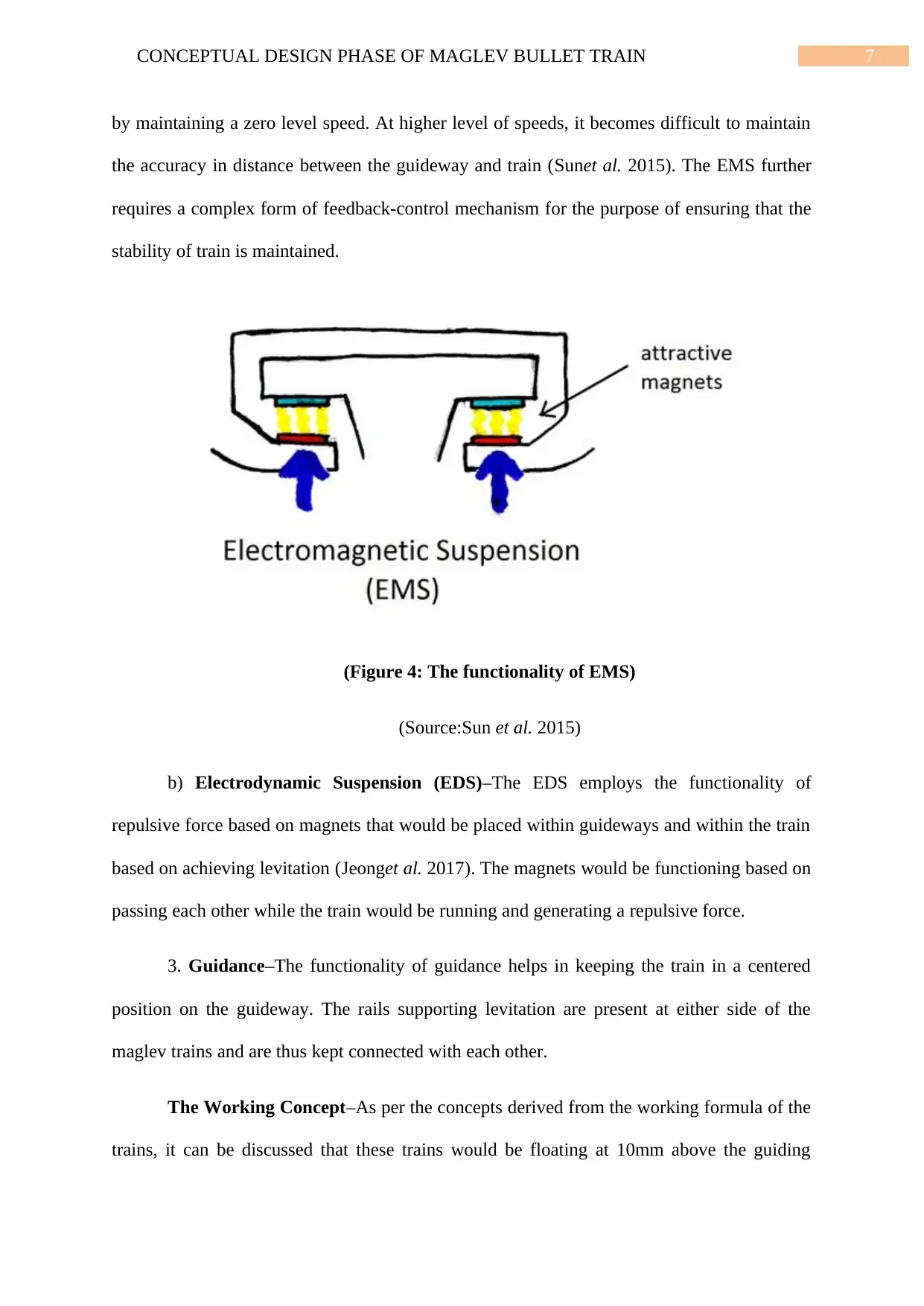
7CONCEPTUAL DESIGN PHASE OF MAGLEV BULLET TRAIN
by maintaining a zero level speed. At higher level of speeds, it becomes difficult to maintain
the accuracy in distance between the guideway and train (Sunet al. 2015). The EMS further
requires a complex form of feedback-control mechanism for the purpose of ensuring that the
stability of train is maintained.
(Figure 4: The functionality of EMS)
(Source:Sun et al. 2015)
b) Electrodynamic Suspension (EDS)–The EDS employs the functionality of
repulsive force based on magnets that would be placed within guideways and within the train
based on achieving levitation (Jeonget al. 2017). The magnets would be functioning based on
passing each other while the train would be running and generating a repulsive force.
3. Guidance–The functionality of guidance helps in keeping the train in a centered
position on the guideway. The rails supporting levitation are present at either side of the
maglev trains and are thus kept connected with each other.
The Working Concept–As per the concepts derived from the working formula of the
trains, it can be discussed that these trains would be floating at 10mm above the guiding
by maintaining a zero level speed. At higher level of speeds, it becomes difficult to maintain
the accuracy in distance between the guideway and train (Sunet al. 2015). The EMS further
requires a complex form of feedback-control mechanism for the purpose of ensuring that the
stability of train is maintained.
(Figure 4: The functionality of EMS)
(Source:Sun et al. 2015)
b) Electrodynamic Suspension (EDS)–The EDS employs the functionality of
repulsive force based on magnets that would be placed within guideways and within the train
based on achieving levitation (Jeonget al. 2017). The magnets would be functioning based on
passing each other while the train would be running and generating a repulsive force.
3. Guidance–The functionality of guidance helps in keeping the train in a centered
position on the guideway. The rails supporting levitation are present at either side of the
maglev trains and are thus kept connected with each other.
The Working Concept–As per the concepts derived from the working formula of the
trains, it can be discussed that these trains would be floating at 10mm above the guiding
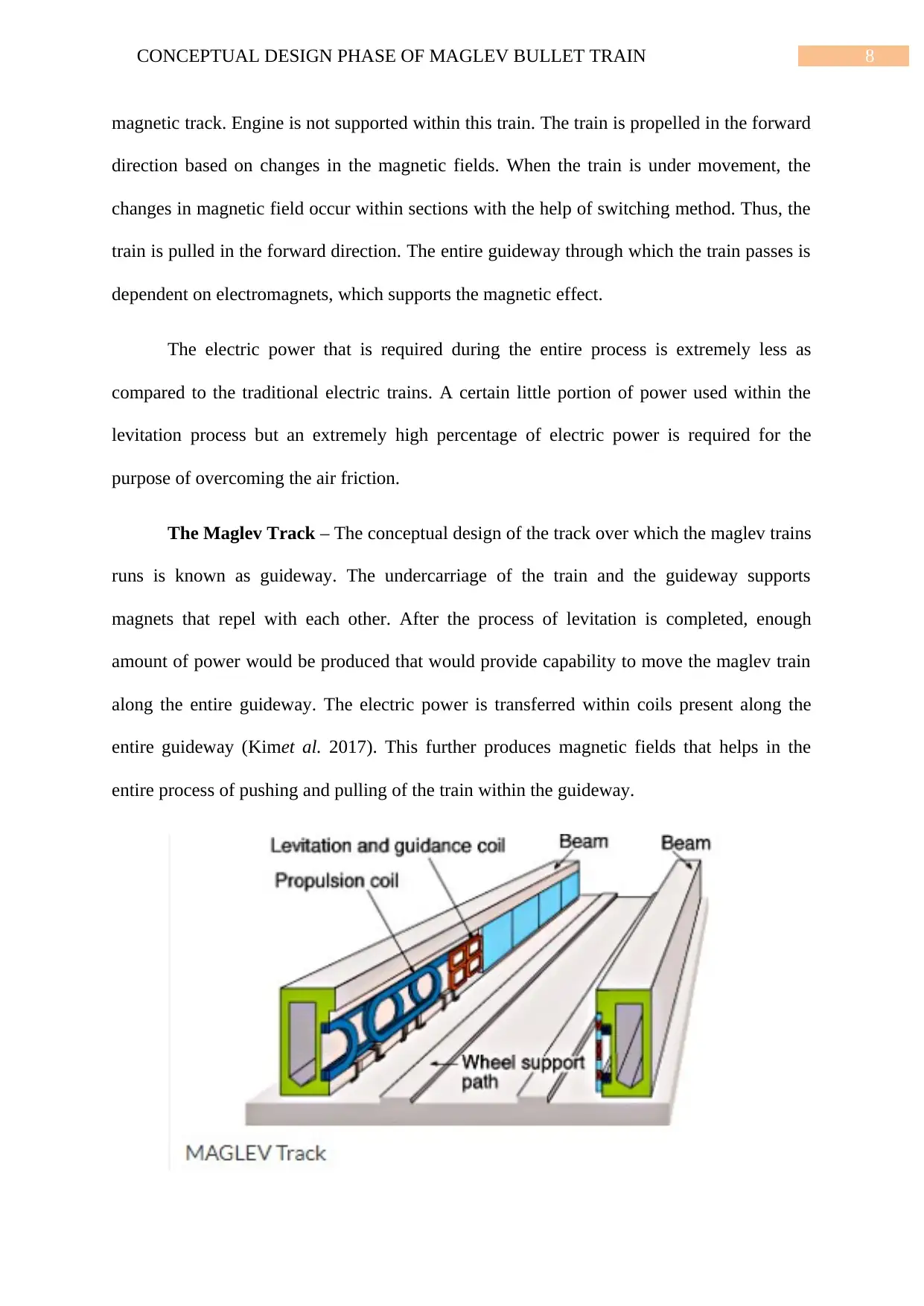
8CONCEPTUAL DESIGN PHASE OF MAGLEV BULLET TRAIN
magnetic track. Engine is not supported within this train. The train is propelled in the forward
direction based on changes in the magnetic fields. When the train is under movement, the
changes in magnetic field occur within sections with the help of switching method. Thus, the
train is pulled in the forward direction. The entire guideway through which the train passes is
dependent on electromagnets, which supports the magnetic effect.
The electric power that is required during the entire process is extremely less as
compared to the traditional electric trains. A certain little portion of power used within the
levitation process but an extremely high percentage of electric power is required for the
purpose of overcoming the air friction.
The Maglev Track – The conceptual design of the track over which the maglev trains
runs is known as guideway. The undercarriage of the train and the guideway supports
magnets that repel with each other. After the process of levitation is completed, enough
amount of power would be produced that would provide capability to move the maglev train
along the entire guideway. The electric power is transferred within coils present along the
entire guideway (Kimet al. 2017). This further produces magnetic fields that helps in the
entire process of pushing and pulling of the train within the guideway.
magnetic track. Engine is not supported within this train. The train is propelled in the forward
direction based on changes in the magnetic fields. When the train is under movement, the
changes in magnetic field occur within sections with the help of switching method. Thus, the
train is pulled in the forward direction. The entire guideway through which the train passes is
dependent on electromagnets, which supports the magnetic effect.
The electric power that is required during the entire process is extremely less as
compared to the traditional electric trains. A certain little portion of power used within the
levitation process but an extremely high percentage of electric power is required for the
purpose of overcoming the air friction.
The Maglev Track – The conceptual design of the track over which the maglev trains
runs is known as guideway. The undercarriage of the train and the guideway supports
magnets that repel with each other. After the process of levitation is completed, enough
amount of power would be produced that would provide capability to move the maglev train
along the entire guideway. The electric power is transferred within coils present along the
entire guideway (Kimet al. 2017). This further produces magnetic fields that helps in the
entire process of pushing and pulling of the train within the guideway.
⊘ This is a preview!⊘
Do you want full access?
Subscribe today to unlock all pages.

Trusted by 1+ million students worldwide
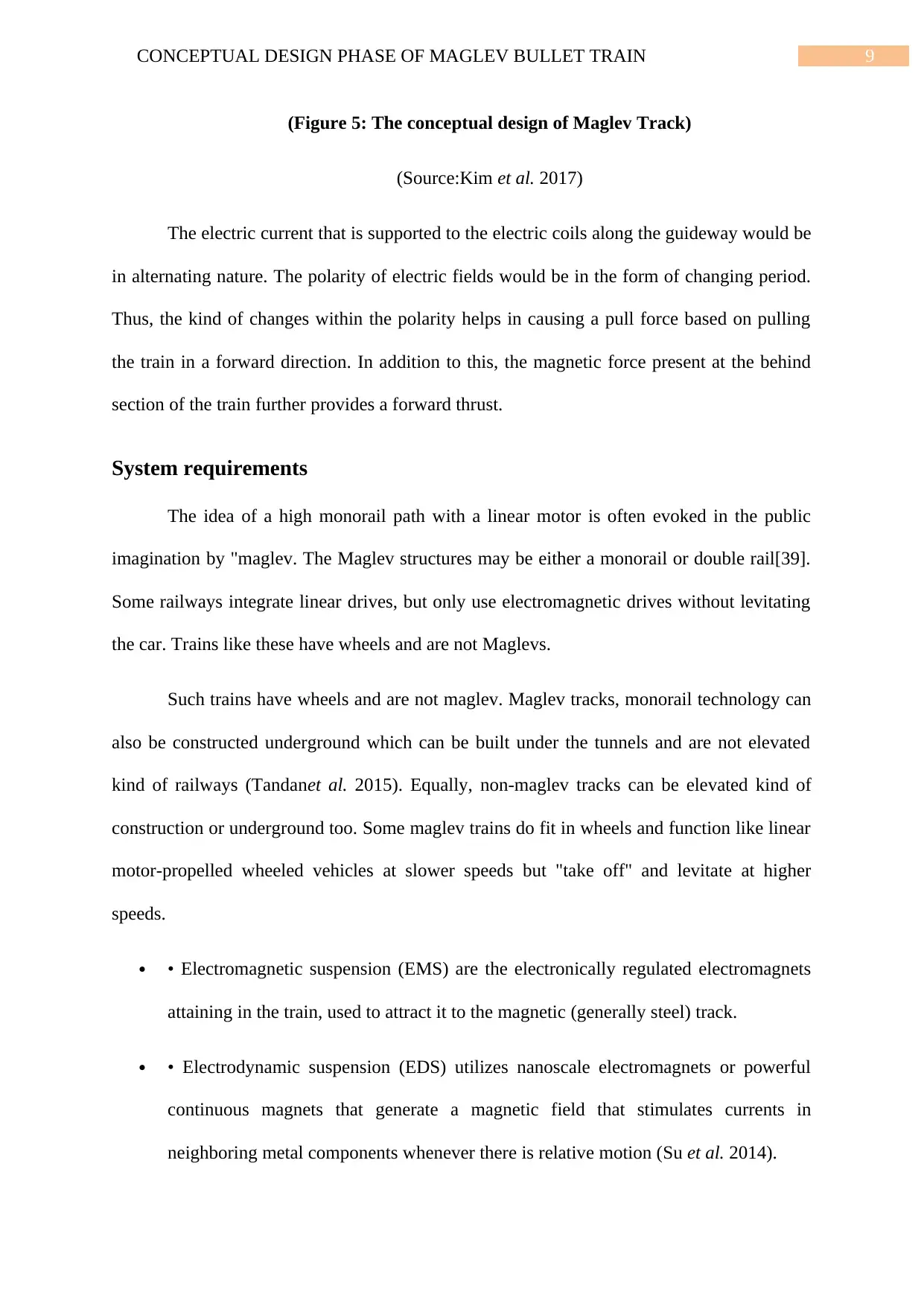
9CONCEPTUAL DESIGN PHASE OF MAGLEV BULLET TRAIN
(Figure 5: The conceptual design of Maglev Track)
(Source:Kim et al. 2017)
The electric current that is supported to the electric coils along the guideway would be
in alternating nature. The polarity of electric fields would be in the form of changing period.
Thus, the kind of changes within the polarity helps in causing a pull force based on pulling
the train in a forward direction. In addition to this, the magnetic force present at the behind
section of the train further provides a forward thrust.
System requirements
The idea of a high monorail path with a linear motor is often evoked in the public
imagination by "maglev. The Maglev structures may be either a monorail or double rail[39].
Some railways integrate linear drives, but only use electromagnetic drives without levitating
the car. Trains like these have wheels and are not Maglevs.
Such trains have wheels and are not maglev. Maglev tracks, monorail technology can
also be constructed underground which can be built under the tunnels and are not elevated
kind of railways (Tandanet al. 2015). Equally, non-maglev tracks can be elevated kind of
construction or underground too. Some maglev trains do fit in wheels and function like linear
motor-propelled wheeled vehicles at slower speeds but "take off" and levitate at higher
speeds.
• Electromagnetic suspension (EMS) are the electronically regulated electromagnets
attaining in the train, used to attract it to the magnetic (generally steel) track.
• Electrodynamic suspension (EDS) utilizes nanoscale electromagnets or powerful
continuous magnets that generate a magnetic field that stimulates currents in
neighboring metal components whenever there is relative motion (Su et al. 2014).
(Figure 5: The conceptual design of Maglev Track)
(Source:Kim et al. 2017)
The electric current that is supported to the electric coils along the guideway would be
in alternating nature. The polarity of electric fields would be in the form of changing period.
Thus, the kind of changes within the polarity helps in causing a pull force based on pulling
the train in a forward direction. In addition to this, the magnetic force present at the behind
section of the train further provides a forward thrust.
System requirements
The idea of a high monorail path with a linear motor is often evoked in the public
imagination by "maglev. The Maglev structures may be either a monorail or double rail[39].
Some railways integrate linear drives, but only use electromagnetic drives without levitating
the car. Trains like these have wheels and are not Maglevs.
Such trains have wheels and are not maglev. Maglev tracks, monorail technology can
also be constructed underground which can be built under the tunnels and are not elevated
kind of railways (Tandanet al. 2015). Equally, non-maglev tracks can be elevated kind of
construction or underground too. Some maglev trains do fit in wheels and function like linear
motor-propelled wheeled vehicles at slower speeds but "take off" and levitate at higher
speeds.
• Electromagnetic suspension (EMS) are the electronically regulated electromagnets
attaining in the train, used to attract it to the magnetic (generally steel) track.
• Electrodynamic suspension (EDS) utilizes nanoscale electromagnets or powerful
continuous magnets that generate a magnetic field that stimulates currents in
neighboring metal components whenever there is relative motion (Su et al. 2014).
Paraphrase This Document
Need a fresh take? Get an instant paraphrase of this document with our AI Paraphraser
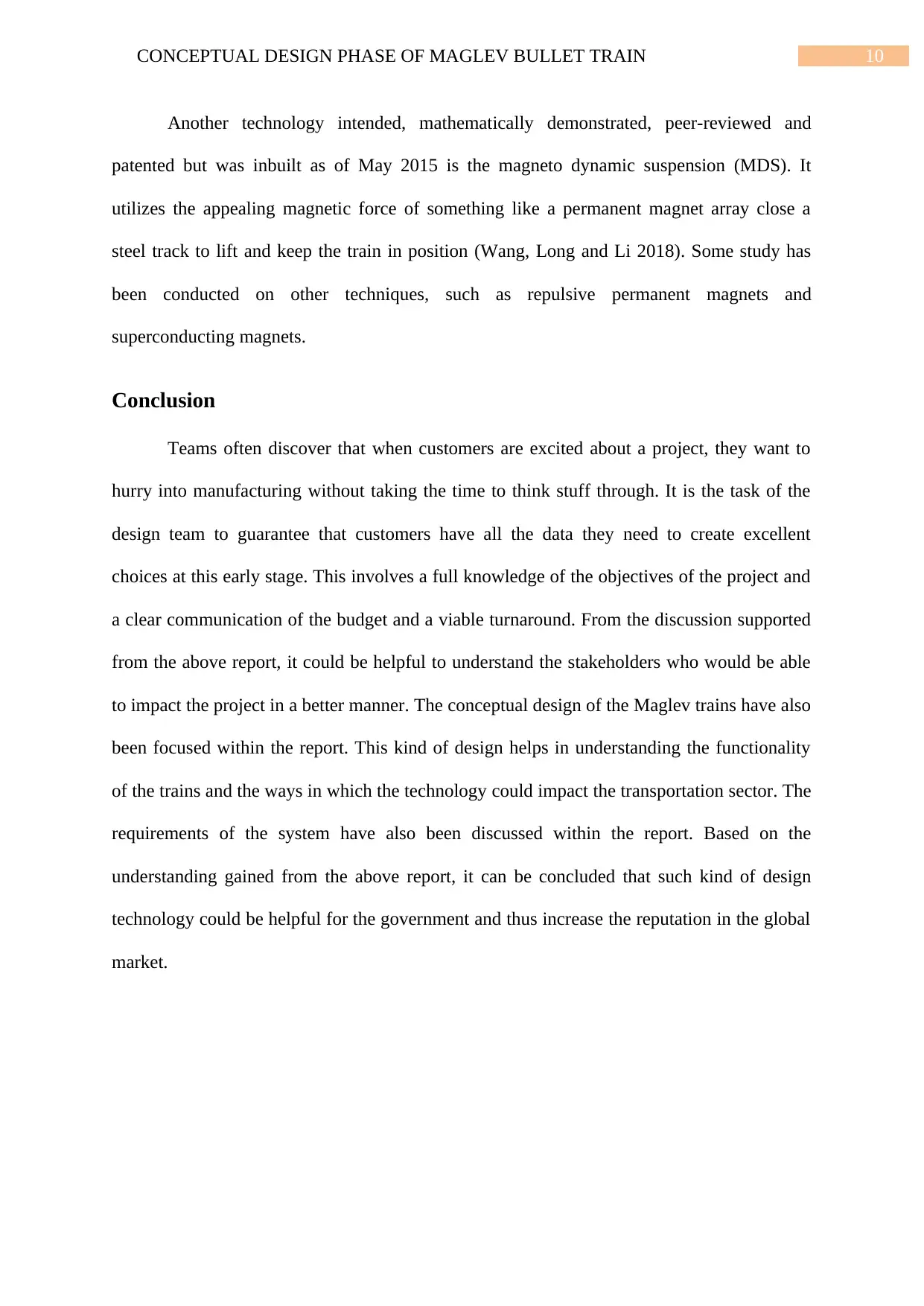
10CONCEPTUAL DESIGN PHASE OF MAGLEV BULLET TRAIN
Another technology intended, mathematically demonstrated, peer-reviewed and
patented but was inbuilt as of May 2015 is the magneto dynamic suspension (MDS). It
utilizes the appealing magnetic force of something like a permanent magnet array close a
steel track to lift and keep the train in position (Wang, Long and Li 2018). Some study has
been conducted on other techniques, such as repulsive permanent magnets and
superconducting magnets.
Conclusion
Teams often discover that when customers are excited about a project, they want to
hurry into manufacturing without taking the time to think stuff through. It is the task of the
design team to guarantee that customers have all the data they need to create excellent
choices at this early stage. This involves a full knowledge of the objectives of the project and
a clear communication of the budget and a viable turnaround. From the discussion supported
from the above report, it could be helpful to understand the stakeholders who would be able
to impact the project in a better manner. The conceptual design of the Maglev trains have also
been focused within the report. This kind of design helps in understanding the functionality
of the trains and the ways in which the technology could impact the transportation sector. The
requirements of the system have also been discussed within the report. Based on the
understanding gained from the above report, it can be concluded that such kind of design
technology could be helpful for the government and thus increase the reputation in the global
market.
Another technology intended, mathematically demonstrated, peer-reviewed and
patented but was inbuilt as of May 2015 is the magneto dynamic suspension (MDS). It
utilizes the appealing magnetic force of something like a permanent magnet array close a
steel track to lift and keep the train in position (Wang, Long and Li 2018). Some study has
been conducted on other techniques, such as repulsive permanent magnets and
superconducting magnets.
Conclusion
Teams often discover that when customers are excited about a project, they want to
hurry into manufacturing without taking the time to think stuff through. It is the task of the
design team to guarantee that customers have all the data they need to create excellent
choices at this early stage. This involves a full knowledge of the objectives of the project and
a clear communication of the budget and a viable turnaround. From the discussion supported
from the above report, it could be helpful to understand the stakeholders who would be able
to impact the project in a better manner. The conceptual design of the Maglev trains have also
been focused within the report. This kind of design helps in understanding the functionality
of the trains and the ways in which the technology could impact the transportation sector. The
requirements of the system have also been discussed within the report. Based on the
understanding gained from the above report, it can be concluded that such kind of design
technology could be helpful for the government and thus increase the reputation in the global
market.
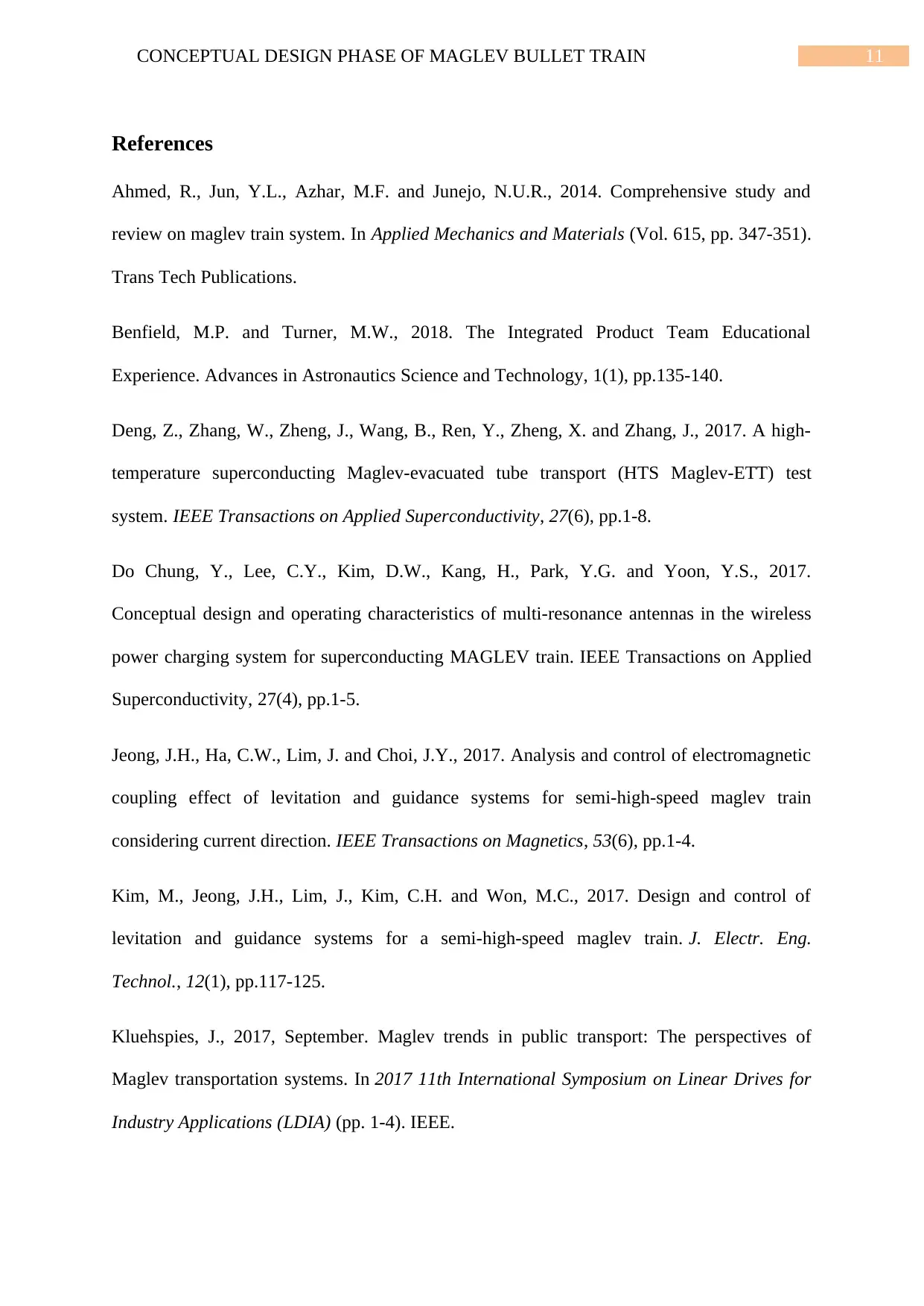
11CONCEPTUAL DESIGN PHASE OF MAGLEV BULLET TRAIN
References
Ahmed, R., Jun, Y.L., Azhar, M.F. and Junejo, N.U.R., 2014. Comprehensive study and
review on maglev train system. In Applied Mechanics and Materials (Vol. 615, pp. 347-351).
Trans Tech Publications.
Benfield, M.P. and Turner, M.W., 2018. The Integrated Product Team Educational
Experience. Advances in Astronautics Science and Technology, 1(1), pp.135-140.
Deng, Z., Zhang, W., Zheng, J., Wang, B., Ren, Y., Zheng, X. and Zhang, J., 2017. A high-
temperature superconducting Maglev-evacuated tube transport (HTS Maglev-ETT) test
system. IEEE Transactions on Applied Superconductivity, 27(6), pp.1-8.
Do Chung, Y., Lee, C.Y., Kim, D.W., Kang, H., Park, Y.G. and Yoon, Y.S., 2017.
Conceptual design and operating characteristics of multi-resonance antennas in the wireless
power charging system for superconducting MAGLEV train. IEEE Transactions on Applied
Superconductivity, 27(4), pp.1-5.
Jeong, J.H., Ha, C.W., Lim, J. and Choi, J.Y., 2017. Analysis and control of electromagnetic
coupling effect of levitation and guidance systems for semi-high-speed maglev train
considering current direction. IEEE Transactions on Magnetics, 53(6), pp.1-4.
Kim, M., Jeong, J.H., Lim, J., Kim, C.H. and Won, M.C., 2017. Design and control of
levitation and guidance systems for a semi-high-speed maglev train. J. Electr. Eng.
Technol., 12(1), pp.117-125.
Kluehspies, J., 2017, September. Maglev trends in public transport: The perspectives of
Maglev transportation systems. In 2017 11th International Symposium on Linear Drives for
Industry Applications (LDIA) (pp. 1-4). IEEE.
References
Ahmed, R., Jun, Y.L., Azhar, M.F. and Junejo, N.U.R., 2014. Comprehensive study and
review on maglev train system. In Applied Mechanics and Materials (Vol. 615, pp. 347-351).
Trans Tech Publications.
Benfield, M.P. and Turner, M.W., 2018. The Integrated Product Team Educational
Experience. Advances in Astronautics Science and Technology, 1(1), pp.135-140.
Deng, Z., Zhang, W., Zheng, J., Wang, B., Ren, Y., Zheng, X. and Zhang, J., 2017. A high-
temperature superconducting Maglev-evacuated tube transport (HTS Maglev-ETT) test
system. IEEE Transactions on Applied Superconductivity, 27(6), pp.1-8.
Do Chung, Y., Lee, C.Y., Kim, D.W., Kang, H., Park, Y.G. and Yoon, Y.S., 2017.
Conceptual design and operating characteristics of multi-resonance antennas in the wireless
power charging system for superconducting MAGLEV train. IEEE Transactions on Applied
Superconductivity, 27(4), pp.1-5.
Jeong, J.H., Ha, C.W., Lim, J. and Choi, J.Y., 2017. Analysis and control of electromagnetic
coupling effect of levitation and guidance systems for semi-high-speed maglev train
considering current direction. IEEE Transactions on Magnetics, 53(6), pp.1-4.
Kim, M., Jeong, J.H., Lim, J., Kim, C.H. and Won, M.C., 2017. Design and control of
levitation and guidance systems for a semi-high-speed maglev train. J. Electr. Eng.
Technol., 12(1), pp.117-125.
Kluehspies, J., 2017, September. Maglev trends in public transport: The perspectives of
Maglev transportation systems. In 2017 11th International Symposium on Linear Drives for
Industry Applications (LDIA) (pp. 1-4). IEEE.
⊘ This is a preview!⊘
Do you want full access?
Subscribe today to unlock all pages.

Trusted by 1+ million students worldwide
1 out of 14
Related Documents
Your All-in-One AI-Powered Toolkit for Academic Success.
+13062052269
info@desklib.com
Available 24*7 on WhatsApp / Email
![[object Object]](/_next/static/media/star-bottom.7253800d.svg)
Unlock your academic potential
Copyright © 2020–2025 A2Z Services. All Rights Reserved. Developed and managed by ZUCOL.




